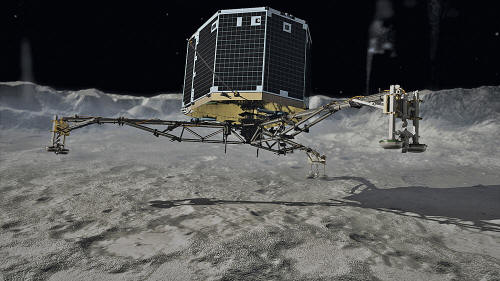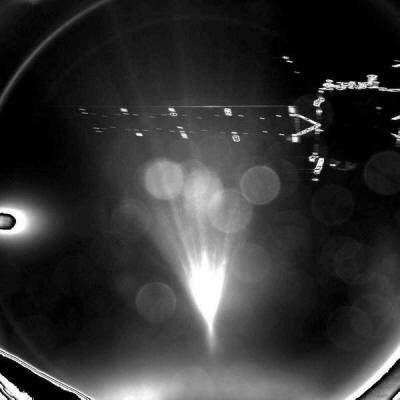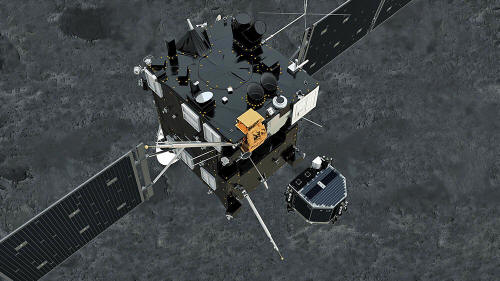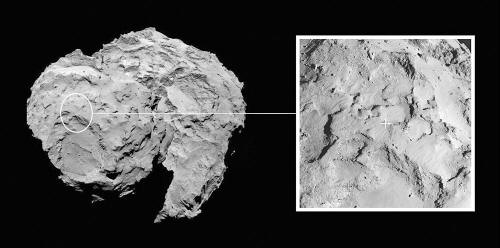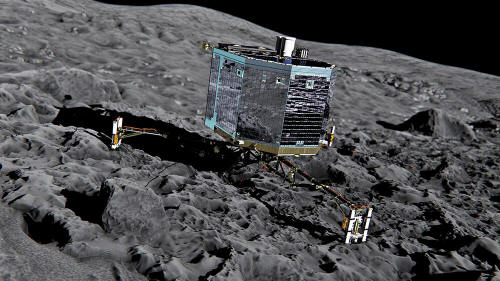|
Here's a live video feed from the European Space Agency (ESA) covering the separation, descent, and (hopeful) landing of Rosetta and Philae.
Original story
Early tomorrow morning, November 12, the European Space Agency will attempt to land on comet 67P, which is currently about 300 million miles away and hurtling towards the Sun.
Philae's first photo of Rosetta, just after separation
The Rosetta spacecraft, which has spent the last 10 years chasing down and orbiting comet 67P/Churyumov-Gerasimenko, will release its Philae lander - and, if everything goes to plan, it will touch down on the comet about seven hours later.
It's an exceedingly complex maneuver, with a good possibility that Philae will miss its landing zone - or, worst-case, miss the comet entirely (67P is only a couple of miles across).
If Philae is successful, it will be the first time that humankind has ever landed on a comet, which would be awesome in the space exploration hell yeah! sense, and also scientifically significant - by landing and drilling into a comet, we'll find out about the origins of the Solar System, and possibly, if we're lucky, of life itself.
How will Rosetta/Philae land on comet 67P?
Starting this evening, the European Space Agency will have a series of four go/no go points - basically, four chances to look at Rosetta's current positioning, and to make sure all the various systems and parameters are set up and ready to go.
If mission control says "no go" at any point, the landing won't occur, and we'll go back to the drawing board for a few days.
Assuming everything goes to plan, though, Rosetta will start with separation…
Rosetta/Philae separation above comet 67P (artist render)
Separation
Rosetta will maneuver itself a bit closer to comet 67P, so that it's about 14 miles (22 km) above the landing site.
Then, when the ESA is absolutely sure that Rosetta is in the perfect position, the Philae lander will be pushed out of a hatch, and slowly begin its descent down to the comet. Separation is scheduled to occur at around 2-3am east coast time.
Philae is fairly small, weighing about 100 kilos (220 lbs), with a leg span of about 1 meter.
Descent
Philae will very, very slowly descend towards its landing site. The 14-mile journey will take between five and 10 hours.
As far as I can tell, this process will be completely unpowered - Philae will have a small amount of velocity from being squeezed out of Rosetta, but it otherwise has no control over its direction or bearing.
Philae's primary landing site, Site J, now named Agilkia
Landing
The ESA knows where it wants Philae to land, but actually hitting the LZ - dubbed Agilkia, after an island on the Nile river - is another matter entirely.
Comet 67P is just 2.5 miles (4 km) in diameter, and Philae will be falling very slowly for hours - if the separation is off by just a few millimeters, Philae could quite easily miss the comet entirely.
The ESA also doesn't know exactly what to expect when the lander gets down to the surface of the comet - it has a good idea, from all the photos that Rosetta has taken, but we won't know the actual relief of the land until Philae actually gets there.
If Philae lands on top of a boulder, we're in trouble.
Fire the harpoons!
If Philae manages to land on a relatively flat bit of ground, two harpoon guns will fire out and (hopefully) secure the lander in place.
There are also screws in the lander's feet that will attempt to bore into the surface of the comet, for further security. Due to the comet's very weak gravity, thrusters will fire upwards to hold Philae in place while the harpoons and screws try to get a purchase. If the surface of the comet is too soft or too hard, Philae could fail to secure itself and just bounce off back into space.
Here's an interesting video with Ian Wright, one of the chief Rosetta scientists, answering some questions about the landing process.
Philae on the surface of comet 67P (artist render)
If everything goes to plan…
After 10 years of chasing a comet half way across the Solar System, the final stage of the Rosetta mission - the most important stage - is both the hardest and the most uncertain.
Even if the astronomers and engineers at ESA HQ do everything perfectly, there's always a painful chance that the mission will be scuppered by a boulder, some soft ground, or another unfortunate quirk of fate.
If everything does go to plan, though, Philae will become one of humanity's greatest scientific endeavors.
Philae will drill down about 20 centimeters (8 inches) into the comet, then analyze those samples with its on-board labs. It will use its CONSERT instrument to analyze the internal structure of the comet, using radio waves to produce a tomogram (as in, the same thing as a computed tomography, CT, scan).
Philae also has some high-res cameras and surface probes. Shortly after arriving on the surface of the comet, if it successfully lands, Philae will send back a panoramic photo.
Over the next six months, as comet 67P's highly elliptical orbit finally brings it closer to the Sun, both Philae and Rosetta will find out even more about the comet's structure and chemical composition as it begins to melt.
In short, if pulls off a successful landing, we're going to find out a lot about comet 67P - which is big news in scientific circles, because we've only ever looked at comets from afar, and have thus made a lot of assumptions about their genesis, structure, and chemical composition.
By actually getting down there and drilling into it, I guarantee that our understanding of comets will change dramatically.
Hypotheses that have held for decades, or even centuries, will be confirmed - or destroyed - in an instant. We will find telltale clues about how the Solar System actually formed four billion years ago - and by association, how the solar systems of trillions of other stars throughout the universe also formed.
If we're lucky, we might even find signs of life, proving the panspermia theory that simple life probably arrived on Earth via a comet or asteroid - but hey, let's not get ahead of ourselves here.
For the latest Rosetta/Philae updates, follow the ESA's Livestream page. Montage comprising 4 Navigation Camera images taken on 28 October. Acquired from 9.7 km height above 67P/C-G. Credits: ESA/Rosetta/NAVCAM
A Singing Comet
Rosetta's Plasma Consortium (RPC) has uncovered a mysterious 'song' that Comet 67P/Churyumov-Gerasimenko is singing into space.
The comet seems to be emitting a 'song' in the form of oscillations in the magnetic field in the comet's environment. It is being sung at 40-50 millihertz, far below human hearing, which typically picks up sound between 20 Hz and 20 kHz.
To make the music audible to the human ear, the frequencies have been increased in this recording.
Original data credit: ESA/Rosetta/RPC/RPC-MAG.
This sonification of the RPC-Mag data was compiled by German composer Manuel Senfft (www.tagirijus.de).
|


